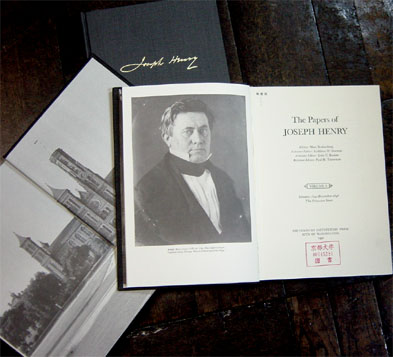Joseph Henry
An American physicist who discovered, around the same time as Michael Faraday, the electro-magnetic induction; he is also responsible for invention of electric motor and telegraphy. Later, after teaching in New Jersey College (now Princeton), Henry became the first Secretary of the Smithsonian Institution (1846-1878).
His career is quite similar to Faraday's up to a certain point: both are largely self-taught, experienced apprenticeship as a boy, and even their religious background is similar---Henry, a Presbyterian, and Faraday, a Sandemanian (a dissenter sect from Presbyterian). However, in sharp contrast to Faraday, Henry became a great figure in the field of scientific administration too---in addition to the job of the Secretary, he became the president of the National Academy of Sciences, and a powerful advocate of basic research in science; his policy was reflected in the Smithsonian activities, and had an impact on American science.
In a letter to Alexander Dallas Bache (Sept. 5, 1846), Henry stated his idea on the Smithsonian Institution as follows:
The object of the institution is the increase and diffusion of knowledge. The increase of knowledge is much more difficult and in reference to the bearing of this institution on the character of our country and the welfare of mankind much more important than the diffusion of knowledge. There are at this time thousands of institutions actively engaged in the diffusion of knlwledge in our country, but not a single one which gives direct support to its increase. Knowledge such as that contemplated by the testator can only be increased by the original research, which requires patient thought and laborious and often expensive experiments. (The Papers of Joseph Henry, vol. 6, 494, Smithsonian Institution Press, 1992)
Thus he emphasized basic research, confining "knowledge" to scientific knowledge. He adhered to this principle and argued against such powerful politicians as Stephen Douglas, a rival of Abraham Lincoln in the 1860 presidential election.

[The Papers of Joseph Henry, 1972-; you can see the Smithsonian Institution on the back of the cover, as well as a portrait of Henry and his signature. Photo by S. Uchii.]
When he died in 1878, a huge funeral service was performed, and later a bronze statue of Henry was placed in front of the Smithsonian "castle". He thus became the symbol of the rising American science.
See Uchii's book review of Moyer's Joseph Henry and "Faraday and Henry" [Japanese]. See also "Joseph Henry: Who was He?" and the sequel, Smithsonian Institution